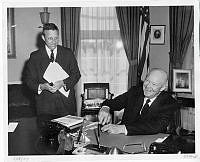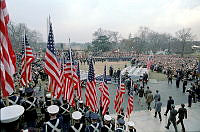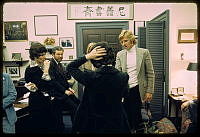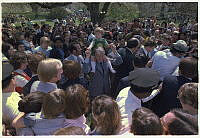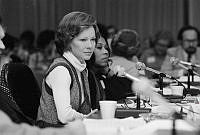The Airborne Ambassador
President Ronald Reagan and Air Force One
Copyright © Fall 2010 White House Historical Association. All rights reserved under international copyright conventions. No part of this article may be reproduced or utilized in any form or by any means, electronic or mechanical, including photocopying, recording, or by any information storage and retrieval system, without permission in writing from the publisher. Requests for reprint permissions should be addressed to books@whha.org
Eighteen years ago when the Ronald Reagan Presidential Library was dedicated, President Reagan expressed his dream that it would bring the presidency closer to the American people. The opening of the Air Force One Pavilion at the Reagan Library in 2005 featuring SAM (Special Air Mission) 27000 marked an important milestone in achieving President Reagan’s wish.
For President Reagan, nothing better represented freedom’s virtue as powerfully as Air Force One. Preserved to provide lessons of leadership, this historic aircraft symbolizes the vast responsibility of the American executive office to maintain not only the freedom of Americans but to nurture freedom where it does not exist. This was Ronald Reagan’s essential philosophy of the greatest rule of the presidency.
When he flew to meet Winston Churchill and Charles de Gaulle in Casablanca, President Franklin Roosevelt became the first American president to travel by air. Over the some twenty-five years between the Dixie Clipper that carried Roosevelt, and the Boeing 707 SAM 26000, used by President John Kennedy, air travel became an integral tool of presidential communication and diplomacy.
For almost a million miles and 444 missions, seven American presidents with thirty years of executive service depended upon SAM 27000. It joined the Eighty-Ninth Airlift Wing at Andrews Air Force Base in 1972 and came into service in 1973.
The historic aircraft flew Richard Nixon to the Middle East to meet with Anwar Sadat and, ironically, was the same plane that returned him to California in August 1974, following his resignation. His successor, Gerald Ford, embarked upon a campaign of global diplomacy by traveling to Vladivostok in the Soviet Union to speak with Leonid Brezhnev, general secretary of the Communist Party. After his election in 1976, Jimmy Carter used the aircraft for both domestic and foreign travel, but his most famous journey occurred immediately after his presidency, when President Reagan sent him to Germany to welcome the fifty-two freed American hostages upon their release from Iran.
For more than two hundred missions and three diplomatic summits—Geneva, Reykjavík, and Moscow—SAM 27000 enabled President Reagan to practice face-to-face diplomacy fueled by his belief, “I have always placed a lot of faith in the simple power of human contact in solving problems.”1 In June 1987, the president headed for Berlin, where he delivered the stirring speech in which he appealed to General Secretary Mikhail Gorbachev to tear down the Berlin Wall.
Number 27000 proved itself one of the most essential soldiers of the Cold War. After that long and protracted episode it served President George H. W. Bush until it was replaced by the new Air Force One, which was planned by President Reagan but not delivered until the George W. Bush administration. By that time the Cold War was over, and 27000 was a relic of that era.
In the summer of 2001, the Ronald Reagan Presidential Foundation was advised that SAM 27000 was going to be retired entirely from service. Immediately, library staff put together a proposal to bring the plane to the Reagan Library and create an exhibit. The proposal was accepted by Secretary of the Air Force James G. Roche. In August 2001, President George W. Bush used this aircraft for a final flight and promptly facilitated the transfer to California. Recognizing President Reagan’s use of the plane at historic meetings that greatly accelerated the collapse of the Soviet Union and the advance of global democracy, President Bush observed: “27000 will carry no more presidents, but it will carry forever the spirit of American democracy.”2
Revising the plane to museum purposes was dubbed Operation Homeward Bound. SAM 27000 touched down for the last time at San Bernardino International Airport California on September 8, 2001. A team of aeronautical and logistics experts determined how to disassemble the aircraft and carefully transport it, more than 100 miles, through the maze of Southern California freeways, to the Reagan Library. The major engineering challenge was removal of the wings and stabilizers that were specifically designed and installed so that they would never come off. When reassembled, 27000 had to look exactly as she did when it was Air Force One.
On June 21, 2003, the aircraft completed a six-hour journey from San Bernardino to the Reagan Library. Over the next two years, the foundation of the pavilion was built, the fuselage rolled into place, and the remainder of the structure built around the aircraft. Reassembly and refinishing of SAM 27000 continued until it was at last ready for its debut in October 2005. Today, millions of visitors tour the unique symbol of the late twentieth-century presidency. They walk around outside it and through its cabins, allowed time to see and thus sense the power of being there when it happened, aboard the “airborne ambassador.”

Prior to being installed for exhibition at the Ronald Reagan Library, SAM 27000 retired, was flown to the San Bernadino International Airport, and then moved to the Reagan Library.

President George W. Bush walks from Marine One toward the White House with his dog Spot, c. 2004.

President Barack Obama is saluted by Air Force members as he waves from Air Force One prior to departing from Andrews Air Force Base en route to Denver, Colorado, February 18, 2010.
Official White House Photo
A new limousine awaits President Obama at the White House on his first day in office. This car will load aboard Air Force One and travel the world with the president.

President Ronald Reagan and Vice President George H.W. Bush on horseback in 1981.

President William J. Clinton and his family vacationing by yacht in Martha’s Vineyard in 1993.

President-elect Barack Obama emerges from a train on January 17, 2009, in Wilmington, Delaware, en route to Washington on a Pullman Georgia 300 railcar. Former President Abraham Lincoln took a similar pre-inaugural whistle-stop tour in 1861.














